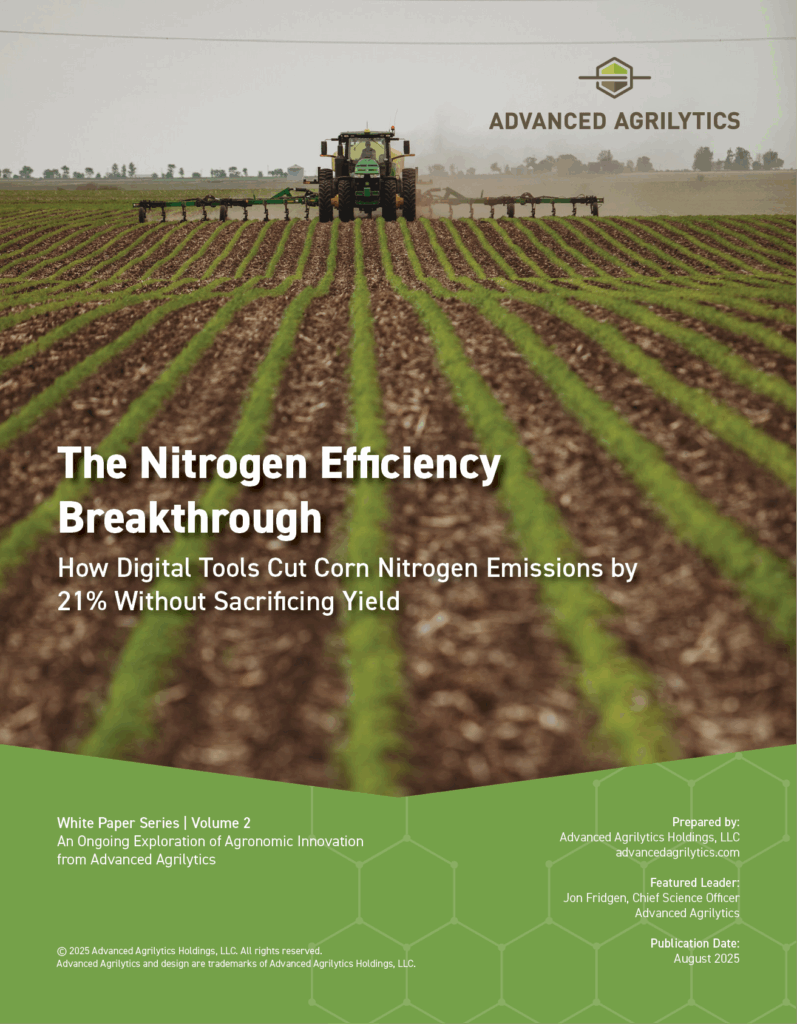In our previous posts, we explored how predictive agronomy helps improve nitrogen efficiency and why that efficiency drives profitability. In this article, we look at another important side of the story: how better nitrogen use efficiency (NUE) supports environmental stewardship, reduces nitrogen loss, and contributes to long-term sustainability at the farm level.

Dig Into the Sustainability Findings
This article draws from The Nitrogen Efficiency Breakthrough white paper, where we measured how improved nitrogen efficiency cuts carbon intensity and reduces N₂O emissions. Read the full research to see how smarter nitrogen use supports both productivity and stewardship.
Nitrogen Efficiency and Environmental Stewardship Go Hand in Hand
For many growers, environmental sustainability can feel like a buzzword that does not always fit the reality of production agriculture. But at its core, it is about making the most of every input, especially nitrogen.
When nitrogen is applied more precisely and used more efficiently, less escapes into the air or leaches through the soil. That means cleaner water, healthier soil, and fewer greenhouse gas emissions.
Efficiency is not about applying less nitrogen overall. It is about applying where and when it will have the greatest impact for the crop, minimizing what is lost to the environment.
What the Data Shows: Efficiency Reduces Loss and Emissions
In The Nitrogen Efficiency Breakthrough white paper, we analyzed NUE across more than 750,000 acres of corn and quantified its impact on emissions and carbon intensity.
The findings were clear. Improving nitrogen efficiency led to a 23.5 percent reduction in carbon intensity and a 21 percent decrease in nitrous oxide (N₂O) emissions per bushel of corn produced.
Those improvements matter because nitrous oxide is nearly 300 times more potent than carbon dioxide as a greenhouse gas. Every pound of nitrogen kept in the field, instead of lost to volatilization or leaching, helps reduce agriculture’s overall carbon footprint.

Why Prediction is Key to Environmental Gains
Nitrogen loss is not just about how much is applied but about how it behaves across different soil and weather conditions. Predictive agronomy uses spatial data to anticipate these variations before the season begins.
By modeling how soil texture, slope, and moisture interact with nitrogen, we can predict where losses are most likely to occur and adjust rates, placement, and timing accordingly. This approach minimizes nitrogen runoff and volatilization while maintaining yield performance.
That is the difference between reactive and predictive management — preventing loss instead of responding to it.

Efficient Nitrogen Use Strengthens Soil Health
Beyond emissions, efficient nitrogen management also supports soil health. Overapplication and surface losses can alter soil chemistry, lower pH, and disrupt microbial activity.
Predictive agronomy maintains the soil’s natural balance by keeping nitrogen in the root zone longer and supports the microbial processes that drive nutrient cycling and organic matter retention. Over time, that leads to healthier, more resilient soils that are better equipped to handle changing weather patterns.
Efficiency as Everyday Stewardship
For growers, the environmental benefits of better NUE are not abstract. They show up in the form of cleaner tile water, improved soil structure, and stronger crop performance year after year.
By focusing on prediction instead of reaction, nitrogen efficiency becomes a practical way to protect both the operation’s productivity and the environment it depends on.
At Advanced Agrilytics, we believe that every efficiency gain is a win for both profitability and stewardship. The data proves that better management today builds a stronger foundation for tomorrow.
Ready to See the Environmental Advantages on Your Acres?
Talk with one of our agronomy experts to learn how predictive nitrogen management can help improve efficiency, reduce losses, and strengthen your farm’s sustainability performance.